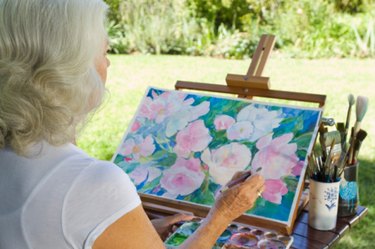Things You'll Need
Gouache paint
Brush
Paper
Spray bottle
Plastic palette
Palette knife

Gouache paint is a watercolor paint with chalk added, which allows the painter to create bolder colors than watercolor and achieve near-complete coverage by painting one color over the other. Gouache behaves very similarly to watercolor paint, including the fact that it "re-wets," meaning that paints can be mixed directly on the paper even after the first layer has dried. Painters can also mix gouache colors in a palette, then apply the mixed colors to the paper. These attributes give gouache paints a versatility that other paints, such as acrylics, lack. Because gouache will continue to re-wet for years after application to a palette, artists can mix color combinations on palettes that they can use for years to come.
Mixing on the Paper
Step 1
Moisten your brush and load it with paint. Paint directly on top of a dried section of gouache to mix the two colors directly onto the paper.
Video of the Day
Step 2
Spray a section of your painting with a light mist to re-wet the colors. You can now add paint directly to the painting to mix the colors you've already applied with new colors.
Step 3
Wipe sections of the painting with a damp paper towel to blend the colors, soften the edges and reveal the lower layers of color that you've applied. Wiping too hard will cause the colors to appear smudged rather than blending or mixing. A moistened cotton swab accomplishes the same goal when working in smaller areas.
Mixing a Palette
Step 1
Squeeze out a dollop of color on one side of a plastic palette, and squeeze out the complimentary color on the other. Complimentary colors are red and green, yellow and purple and blue and orange.
Step 2
Pull each color to the center of the palette, using a palette knife, and mix them in the middle. At the very center of the palette, the color should appear very dark, with increasingly lighter shades as you move toward the colors at either end.
Step 3
Add dollops of white paint at the edges to lighten the intensity of the colors in the palette. Add dollops of other colors to add tints to the two complementary colors you've chosen.
Tip
Gouache paint has both a masstone -- the pigment used primarily in creating the paint -- and an undertone or bias that gives the color a hint of another color. For example, a blue paint may have a green or a red undertone or bias. When mixing paint, consider both the masstone and the undertone. Mixing two paints with the same undertone will create a cleaner undertone. For example, blue and yellow paints with blue undertones will create a clean green when mixed. Primary colors, also available in gouache, are those colors lacking an undertone, where the color falls midway between the other two primary colors.
Video of the Day